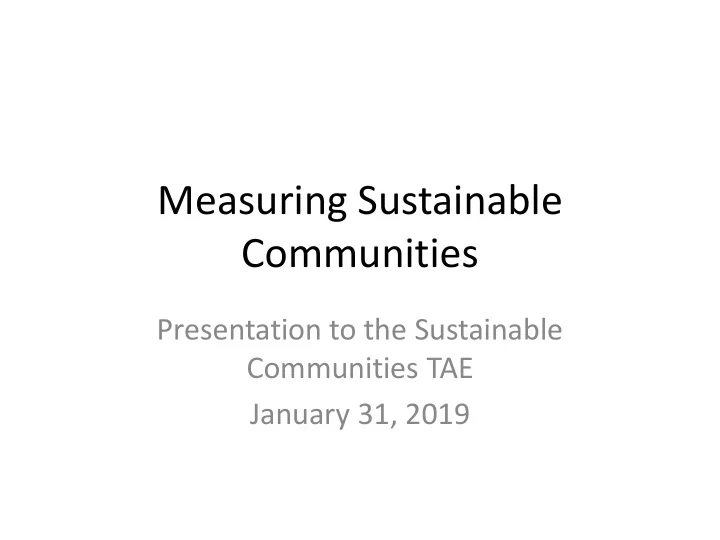

Measuring Sustainable Communities Presentation to the Sustainable Communities TAE January 31, 2019
Overview • Why sustainable communities? • Existing sustainability assessment systems • Problems for use as a community sustainability assessment system • Suggestions for a CSAS – Definition of sustainable community – Principles • Examples
Why Sustainable Communities? • It’s where we live, work, socialize . . . consume (energy, water, goods), dispose of wastes (air, land, water) • Community rather than “urban” or “municipality” – Emphasizes place – But not strict boundaries – And applies to rural/suburban/urban/region
Sustainability Assessment Developed By Project Scale System Agenda 21 United Nations X Global Millennium Development United Nations X Global Goals (MDG) Sustainable Development United Nations X Global Goals (SDG)
Sustainability Developed By Index Scale Assessment System Ecological Footprint (EF) Wackernagel and Rees (1990) X Unclear Consortium including the Yale Center X National for Law and Environmental Policy and Environmental the Center for International Earth Sustainability Indicator Science Information Network at (ESI) Columbia University Genuine Progress Redefining Progress, a nonpartisan, X National/State Indicator (GPI) nonprofit organization Index of Sustainable Daly and Cobb (1989) X National Economic Welfare (ISEW) Human Development United Nations Development X National Index (HDI) Program Environmental South Pacific Applied Geoscience X National Vulnerability Index (EVI) Commission, the United Nations Environment Programme, and their partners Living Planet Index (LPI) Zoological Society of London and X Global World Wildlife Fund Genuine Savings (GS) World Bank Environment Department X National City Development Index Second United Nations Conference X City (CDI) on Human Settlements
Sustainability Assessment Developed By Tool Scale System Leadership for Energy and US Green Building Council X Neighborhood Environmental Design for Neighborhood Development (LEED-ND) BREEAM Communities United Kingdom X Neighborhood (BREEAM-C) CASBEE for Urban Japan Green Building Council/Japan X Neighborhood Development (CASBEE-UD) Sustainable Building Consortium STAR Communities ICLEI-Local Governments for X Municipality Sustainability, the U.S. Green Building Council, and the Center for American Progress
Problems with Existing SAS • Scale and generalizability • Definition of sustainability • Implementation issues
Scale and Generalizability • Many designed for global or national scale • Neighborhood too small • “Leakage” • Generalizability
Definition of Sustainability • 3 Es perspective • Interconnected nature • Weak vs. strong sustainability • Relationship of indicator to definition
Implementation Issues • Static versus dynamic • Ability to communicate with a larger audience • Number of indicators • Weighting • Presentation/transparency
Moving forward . . . A sustainable community is the aggregate of functionally and socially connected individuals and organizations that share collective resources in such a way that engages members in self- determination governance processes resulting in equitable provisioning of the health, educational, and material well-being among its residents while not negatively affecting future generations or other communities’ use of these resources.
Systems Approach • Define community based on system to capture leakage • Not driven by policy or data
Logic Model Approach Inputs Activities Outputs Outcomes Impacts Construction Drinking Gallons of $ public of water water water funding treatment standards Clean, treated plans met renewable, and accessible drinking Conservation Protection of Acres Water supply water zoning watershed protected replenished
Relevant Systems System Indicator Scale Energy “Green” energy consumption State? Water Recharge rate Watershed Land Soil contamination Any Air Air pollution Point measurements Climate CO 2 emissions (equivalents)/person Any Ecosystem Habitat loss Habitat type Waste Landfilled trash/person Landfill service area Economics Poverty Housing Adequate housing Education Secondary education completion Commuting area Food Food security Health Access to health care
SOME FUN CHALLENGES
Energy Exports Energy Generation Energy Consumption CO 2 Energy Imports
Source: Conservation Institute https://www.conservationinstitute.org/water-cycle/ Aquifer map Groundwater monitoring
Interactive map
And on the human system side . . . Metric Binghamton Broome Binghamton Census Tract 13 MSA County % of adult 9.7% 9.6% 14.9% 27.3% population with < H.S. education % of families in 10.1% 10.8% 24.5% 60.5% poverty % of 25.1% 26.4% 39.6% 66.7% households with housing costs >30%
The Importance of Equity Metric Binghamton Broome Binghamton Census Tract 13 MSA County % of adult 9.7% 9.6% 14.9% 27.3% population with < H.S. education % of families in 10.1% 10.8% 24.5% 60.5% poverty % poverty 25.1% 26.4% 52.0% 75.3% (African American) % of 25.1% 26.4% 39.6% 66.7% households with housing costs >30% Gini index 0.46 0.46 0.51 0.48
A Comparison Binghamton Burlington Energy (% “green” 23.6% (includes nuclear and 24.0% (includes hydro); power consumption) hydro); state level (2016) state level (2016) Energy (% green 62%; state level (Oct 2018) 100%; state level (Oct electricity 2018) generation) Energy (consumption 185 mil Btu/50 206 mil Btu/45 per capita/state rank) Groundwater levels Much above normal (Castle Normal (Chitenden County Creek well, 1/30/2019) well, January 2019) % habitat loss 23.3% (Allegheny Mountain 54.4% (Eastern Great Lakes Highlands) Lowland Forest) AQI 33 (good) (EPA AirNow, NYDEC) 30 (good) 11:00 am 1/31/19
The Human Systems Binghamton Burlington % of adult population 9.7% (MSA) 6.8% (MSA) with < H.S. education % of families in 10.1% (MSA) 5.8% (MSA) poverty % of households with 25.1% (MSA) 30.9% (MSA) housing costs >30% Gini index 0.46 (MSA) 0.45 (MSA) Physically unhealthy 3.6 (County) 2.8 (County) days per month Mentally unhealthy 3.7 (County) 3.1 (County) days per month Food environment 8 (County) 8 (County) index * * The Food Environment Index ranges from 0 (worst) to 10 (best) and equally weights two indicators of the food environment: Limited access to healthy foods and Food insecurity.
Wrapping Up • Outcomes not inputs, activities, or outputs • Choosing appropriate scale • Using multiple scales • Pay attention to equity
Recommend
More recommend